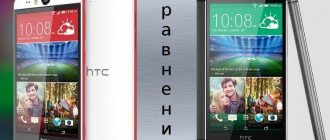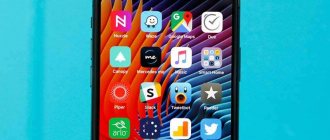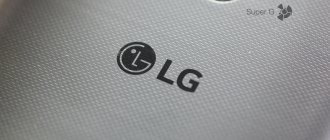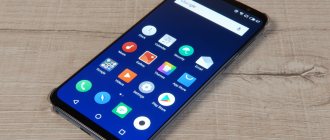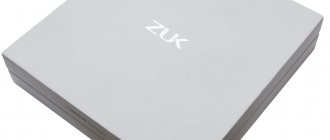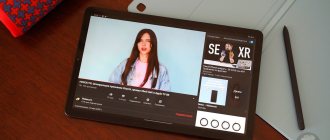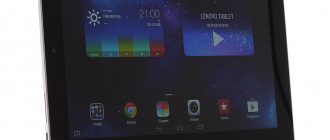Classic copy of the iPad in a metal case
Mi Pad has always tried to be an iPad Mini . The new generation was no exception. What to expect from a classic 8-inch tablet?
This is the same metal all-in-one, the back is completely identical to the iPad Mini thanks to the plastic insert and the protruding camera. Or Xiaomi A2. Looks like everything.
Who prevented you from hiding the module? Oh those developers. And the plug for the antennas can be made more carefully.
The material used is aluminum and plastic. It’s pleasant to hold: the body is “matte”, rough. This makes the rather large tablet more grippy. It will not slip out of your hand, although it weighs a noticeable 340 grams.
The controls follow the concept of Xiaomi smartphones: between the pair of speakers at the bottom there is a USB Type-C , a headphone jack at the top, power and rocker on the right, and the left side carries only a memory card tray.
Or a combined tray for microSD and flash cards with LTE . There is also such a version, and it costs a little more.
ATTENTION: Xiaomi Mi Pad 4 does not support 2G/GSM and 3G/HDSPA. Voice calls are not possible.
As in Xiaomi smartphones, there are no touch buttons under the screen - they are replaced by on-screen keys. Due to the lack of a fingerprint scanner, the solution is so-so.
Frames are not being abandoned yet
The weirdness The weirdness is in the details. Mi Pad 4 has an 8-inch screen with a 16:10 resolution ratio 1920×1200.
That is, this is a slightly elongated (since it is buttonless) screen 7.9 of previous generations, equipped with 4:3 ratio matrices at 2048 × 1536 . Need I say that the modification was not beneficial?
And this despite the use of IPS (respectively, excellent viewing angles) without an air gap, and a generally good pixel density of 283 pixels/inch .
The maximum brightness has also become lower and is now 457 cd/m²: in the sun this is a stretch. But the image is juicy, bright and pleasant.
The minimum brightness is 1.7 cd/m², so as a reader in complete darkness, the Mi Pad 4 fully justifies itself. In this regard, the absence of navigation keys is beneficial.
Compromise of performance and autonomy
When releasing the Xiaomi Mi Pad 4, the developers focused on the “powerful processor” Qualcomm Snapdragon 660 . And this decision also seems strange.
Of course, the previous generation of the company’s tablets did not shine with anything amazing - the performance of the Mi Pad 3 was so-so, but the second generation used perhaps the most interesting Intel processor. And dualBoot with Windows 10!
Alas, now the niche of hybrids is occupied by Chuwi , Teсlast and Co. Therefore, the Four got a Snapdragon 660 with an Adreno 512 video accelerator.
For a mobile device, the performance is excellent - the processor matches the Snapdragon 821 , surpassing it in energy efficiency and graphics power. And it doesn't throttle.
The younger version of Mi Pad 4 is equipped with 3/32 GB of memory. The older and LTE modifications are equipped with 4 GB of RAM and 64 GB of storage.
All options work with microSD cards, so built-in memory doesn't matter. But for LTE in the older version it’s worth paying extra: Bluetooth 5 and Wi-Fi 802.11ac won’t be enough.
The “cold” processor made it possible to achieve impressive autonomy from the Mi Pad 4’s 6000 mAh (the same as in previous versions).
Games eat it up in 7 hours, reading or surfing - in 9-10, depending on the intensity of use and screen brightness. They didn't deliver fast charging, the process will take an hour.
Review of the 8-inch Xiaomi Mi Pad 4 tablet
The tablet market has long been in a very sad state: there are just a few bright new products, and no special innovations have been seen for a long time. For tech geeks, this is, of course, sad. But for ordinary users, this has its advantages, since there is no point in chasing the newest, models remain relevant for a long time, and their prices do not go up and are systematically reduced over a long life cycle. One of these time-tested models is the Xiaomi Mi Pad 4, an eight-inch analogue of the iPad mini, which today can be bought at about half the price of its Apple competitor. Mi Pad 4 was released more than a year ago, but remains relevant, and many readers are interested in details about this device. So we decided to test it in detail using our method and compare it with the Mini.
Characteristics of Xiaomi Mi Pad 4
Let's look at the characteristics of the device and, for clarity, compare them with the current iPad mini. Yes, it came out later, but since Xiaomi still hasn’t released the next generation of eight-inch tablet, the comparison is quite appropriate.
| Xiaomi Mi Pad 4 | iPad mini (2019) | |
| Screen | IPS, 8.0″, 1920×1200 (283 ppi) | IPS, 7.9″, 2048×1536 (326 ppi) |
| SoC (processor) | Qualcomm Snapdragon 660 (8 cores, 4+4) | Apple A12 Bionic (6 cores, 2+4) + M12 coprocessor |
| Flash memory | 32/64 GB | 64/256/512 GB |
| Memory card support | microSD (up to 256 GB) | via a proprietary Lightning adapter |
| Connectors | USB-C, 3.5mm headphone jack | Lightning, 3.5mm headphone jack |
| Cameras | front (5 MP) and rear (13 MP, video recording 1080p 30p) | front (7 MP, video 1080p via FaceTime) and rear (8 MP, video shooting 1080p 60p) |
| Internet | Wi-Fi 802.11a/b/g/n/ac MIMO (2.4 + 5 GHz), optional 3G/4G | Wi-Fi 802.11a/b/g/n/ac MIMO (2.4 + 5 GHz), optional 3G/4G |
| Safety | user face scanner | Touch ID fingerprint scanner |
| Cover-keyboard/stylus support | No | no / Apple Pencil first generation |
| Battery (mAh) | 6000 | 5124 |
| Dimensions (mm) | 200×120×8 | 203×135×6 |
| Weight (g) | 343 | 301 |
| Retail offers Xiaomi Mi Pad 4 64 GB | find out the price | |
| Retail offers Xiaomi Mi Pad 4 64 GB with 4G support | find out the price | |
In terms of characteristics, the Xiaomi tablet is superior in some ways to the iPad mini, and inferior in others. However, due to different operating systems, devices cannot be compared directly. For example, Xiaomi Mi Pad 4 has a larger battery capacity, but this does not mean that it lasts longer on a single charge. In turn, the iPad mini has much more internal memory, but the ability to use a memory card partially eliminates this difference for the Xiaomi tablet.
The situation with the dimensions is interesting: with almost the same screen area, the Xiaomi Mi Pad 4 is slightly smaller on both sides, but almost 2 mm thicker, which is quite significant.
Packaging and equipment
The Xiaomi Mi Pad 4 box clearly resembles both the shape and style of the iPad mini packaging.
The packaging is also identical: 5 V 2 A charger, USB-C cable, envelope with leaflets and a paper clip for removing the memory card slot.
In general, there are no surprises; There is nothing to praise, nor, indeed, to scold. We just note that charging is still two-amp, which is a plus.
Design
The appearance of the tablet makes a pleasant impression. The metal body of a golden (in the case of our sample) hue looks laconic and expensive, although if you look closely, you will notice that it is not made of a single piece of aluminum, like the iPad mini, but of two parts: there is a joint between the back cover and the edges.
At the same time, the thickness of the device is small, and overall the tablet is compact, which is also facilitated by the relatively narrow frame around the screen.
The thickness of the frame on the bottom is the same as on the top - this is possible due to the absence of buttons at the bottom. There is also no fingerprint scanner; instead, it is proposed to use facial recognition. Thus, the Xiaomi Mi Pad 4 is even more advanced in terms of security than the iPad mini, which still has Touch ID rather than Face ID.
The arrangement of buttons and connectors is quite typical: bottom center is USB-C, top right is a 3.5 mm headset jack, on the left side is a combined slot for a memory card and SIM card (you can install both at the same time), and at the top right is power button and volume rocker.
Unfortunately, there is only one speaker - its grilles are located on the bottom edge. And the sound here is very mediocre. For watching TV series and videos on YouTube, it’s hardly enough, but for more, it’s not.
On the back side, near the top edge, you can see a plastic insert necessary for the normal operation of wireless communication modules. It is painted the same color as the metal parts of the tablet, so it is not noticeable. The main camera protrudes noticeably above the surface level, but this cannot be called a big drawback either - everything looks quite normal. The camera does not have a flash.
The tablet fits perfectly into a man's hand; it is not too slippery - in this regard, metal is better than glass or glossy plastic. However, the Mi Pad 4 is noticeably heavier than the iPad mini, and this may cause some discomfort.
In general, the design is not bad, pleasant, but the details show that this is still not a flagship: thickness and weight, non-unibody body, weak speaker...
Screen
The front surface of the screen is made in the form of a glass plate with a mirror-smooth surface that is scratch-resistant. Judging by the reflection of objects, the anti-glare properties of the screen are approximately the same as those of the Google Nexus 7 (2013) screen (hereinafter simply Nexus 7). For clarity, here is a photo in which a white surface is reflected in the switched off screens (on the left - Nexus 7, on the right - Xiaomi Mi Pad 4, then they can be distinguished by size):
The screen of the Xiaomi Mi Pad 4 is a little lighter (brightness according to photographs is 125 versus 120 for the Nexus 7). The ghosting of reflected objects in the Xiaomi Mi Pad 4 screen is very weak, this indicates that there is no air gap between the layers of the screen (more specifically, between the outer glass and the surface of the LCD matrix) (OGS - One Glass Solution type screen). Due to the smaller number of boundaries (glass/air type) with very different refractive indices, such screens look better in conditions of intense external illumination, but their repair in the case of cracked external glass is much more expensive, since the entire screen has to be replaced. The outer surface of the screen has a special oleophobic (grease-repellent) coating (slightly better in efficiency than the Nexus 7), so fingerprints are removed much more easily and appear at a lower speed than with regular glass.
With manual brightness control and when the white field was displayed in full screen, the maximum brightness value was about 415 cd/m², the minimum was 1.2 cd/m². The maximum brightness is quite high, and, given the good anti-glare properties, even on a sunny day outdoors you can see something on the screen. In complete darkness, the brightness can be reduced to a comfortable value. There is automatic brightness adjustment based on the light sensor (it is located to the left of the front camera). In automatic mode, as external lighting conditions change, the screen brightness both increases and decreases. The operation of this function depends on the position of the brightness adjustment slider: with it the user can try to set the desired brightness level in the current conditions. If you do not interfere, then in complete darkness the auto-brightness function reduces the brightness to 5 cd/m² (quite low), in an office illuminated by artificial light (approximately 550 lux) it sets it to 140-150 cd/m² (normal), in a very bright environment (corresponding to lighting on a clear day outdoors, but without direct sunlight - 20,000 lux or a little more) increases to 415 cd/m² (to the maximum, as needed). We slightly increased the brightness in complete darkness and got 15 cd/m² in complete darkness, 160 cd/m² in an artificially lit office, and 415 cd/m² in a very bright environment; we were happy with this result. It turns out that the auto-brightness function works adequately and allows the user to customize their work to individual requirements. Only at very low brightness levels does significant backlight modulation appear, but its frequency is high, about 2.3 kHz, so there is no visible flicker of the screen (but perhaps it can be detected in a test for the presence of a stroboscopic effect - we, however, did not succeed) .
This device uses an IPS type matrix. The microphotographs show a typical IPS subpixel structure:
For comparison, you can see the gallery of microphotographs of screens used in mobile technology.
The screen has good viewing angles without significant color shift even with large viewing deviations from perpendicular to the screen and without inverting shades. For comparison, here are photographs in which the same images are displayed on the screens of Xiaomi Mi Pad 4 and Nexus 7, while the screen brightness is initially set to approximately 200 cd/m², and the color balance on the camera is forced to switch to 6500 K.
There is a white field perpendicular to the screens:
Note the good uniformity of brightness and color tone of the white field.
And a test picture:
The colors on the screen of the Xiaomi Mi Pad 4 have a natural saturation, the color balance of the Nexus 7 and the tested screen is slightly different. The photo was taken with the Auto Configuration profile selected by default in the screen settings:
In the case of the Enhanced profile, there are no noticeable differences from the Auto Adjust profile, but when choosing the Standard profile, the color balance changes slightly - the colors become a little warmer. However, approximately the same result can be achieved in the case of the Auto-Tuning profile by selecting the Warm option.
Now at an angle of approximately 45 degrees to the plane and to the side of the screen:
It can be seen that the colors have not changed much on both screens, but on the Xiaomi Mi Pad 4 the contrast has decreased to a greater extent due to the strong brightening of black.
And a white field:
The brightness at an angle of the screens has decreased (at least 4 times, based on the difference in shutter speed), but the Xiaomi Mi Pad 4 has a slightly brighter screen at this angle. When deviated diagonally, the black field becomes much lighter, but remains relatively neutral gray. The photographs below demonstrate this (the brightness of the white areas in the direction perpendicular to the plane of the screens is the same!):
And from another angle:
When viewed perpendicularly, the uniformity of the black field is average, since closer to the corners the screen brightens a little:
The contrast (approximately in the center of the screen) is high - about 900:1. The response time for the black-white-black transition is 27 ms (18 ms on + 9 ms off). The transition between halftones of gray 25% and 75% (based on the numerical value of the color) and back takes a total of 39 ms. The gamma curve, constructed using 32 points with equal intervals based on the numerical value of the shade of gray, did not reveal any blockage in either the highlights or the shadows. The exponent of the approximating power function is 2.13, which is slightly lower than the standard value of 2.2. In this case, the real gamma curve deviates slightly from the power-law dependence:
This device has a dynamic adjustment of the backlight brightness with a non-obvious dependence on time and on the nature of the displayed image. As a result, the resulting dependence of brightness on hue (gamma curve) may not correspond to the gamma curve of a static image, since the measurements were carried out with sequential display of shades of gray on almost the entire screen. For this reason, we carried out a number of tests - determining contrast and response time, comparing black illumination at angles - (however, as always) when displaying special templates with a constant average brightness, and not monochromatic fields in the entire screen. In general, such non-disabled brightness correction does nothing but harm, since constantly changing the screen brightness can at least cause some discomfort. In this case, when you change the displayed image, the screen brightness may suddenly and very noticeably change, which is annoying.
The color gamut is very close to sRGB:
The spectra show that the matrix filters moderately mix the components with each other:
By default, the color temperature is high, about 7700 K. However, in this device, when you select the Auto Adjust profile, you can adjust the color balance by adjusting the hue with a point on the color wheel or by selecting preset options. In addition, correction is performed automatically when you select the Standard profile.
The result after manual correction (as in the image above) is very good (see graphs below), since the color temperature becomes close to the standard 6500 K, and the deviation from the blackbody spectrum (ΔE) is below 10, which is considered a good indicator for a consumer device. At the same time, color temperature and ΔE change little from hue to hue - this has a positive effect on the visual assessment of color balance. (The darkest areas of the gray scale can be ignored, since color balance there is not very important, and the error in measuring color characteristics at low brightness is large.)
However, it is enough to select the Standard profile, since manual correction is only slightly better than the preset profile.
In the settings you can reduce the intensity of the blue component:
In principle, bright light can lead to disruption of the circadian rhythm (see the article about the iPad Pro with a 9.7-inch display), but everything can be solved by adjusting the brightness to a comfortable level, and there is absolutely no way to distort the color balance, reducing the contribution of blue sense.
Let's summarize: the screen has a fairly high maximum brightness and has good anti-glare properties, so the device can somehow be used outdoors even on a sunny summer day. In complete darkness, the brightness can be reduced to a comfortable level. It is also possible to use a mode with automatic brightness adjustment, which works adequately. The advantages of the screen include the presence of an effective oleophobic coating, the absence of an air gap in the layers of the screen and visible flicker, high contrast, as well as a color gamut close to sRGB and good color balance (after selecting the desired profile). The disadvantages are the low stability of black to the deviation of the gaze from perpendicular to the screen plane and the non-switchable brightness adjustment depending on the displayed image. Nevertheless, taking into account the importance of characteristics for this particular class of devices, the quality of the screen can be considered high.
Performance
The Xiaomi tablet is based on the already quite old, but very popular mid-level Qualcomm SoC - Snapdragon 660. In general, tablets today use mainly those platforms that are installed in mid-range and budget smartphones, here the difference between the two types of mobile devices is clearly visible. Snapdragon 660 includes 8 processor cores (4×Kryo 260 Gold (Cortex-A73) @2.2 GHz + 4×Kryo 260 Silver (Cortex-A53) @1.8 GHz) and Adreno 512 GPU.
Let's start with browser tests: SunSpider 1.0, Octane Benchmark, Kraken Benchmark and JetStream. The tests were performed in Safari on iOS and Chrome on Xiaomi, so comparisons can only be made with great reservations. JetStream 2 tested only the Mi Pad, since this test was not yet available at the time the iPad mini was released.
| Xiaomi Mi Pad 4 (Qualcomm Snapdragon 660) | Apple iPad Mini (Apple A12 Bionic) | |
| SunSpider 1.0.2 (ms, less is better) | 701 | 122 |
| Octane 2.0 (points, more is better) | 9821 | 40435 |
| Kraken Benchmark 1.1 (ms, lower is better) | 4083 | 645 |
| JetStream 1 / 2 (points, more is better) | 54 / 32 | 265 / — |
The result is eloquent. The difference between tablets is so great that we can say without hesitation that surfing the web on an iPad is still much more comfortable.
Now let's see how the Xiaomi tablet performs in Geekbench, a multi-platform benchmark that measures CPU and RAM performance, as well as GPU computing capabilities. Plus, we haven’t forgotten about the comprehensive AnTuTu Benchmark. Unfortunately, we tested the iPad mini in the current version of Geekbench 4 at the time of its release, and now the fifth version has been released, and their results are incompatible. As a result, we had to take data on the iPad mini from the Geekbench database. However, the difference with Xiaomi Mi Pad 4 is again such that a small error here will not make a difference.
| Xiaomi Mi Pad 4 (Qualcomm Snapdragon 660) | Apple iPad Mini (Apple A12 Bionic) | |
| Geekbench 5 Single-Core Score (scores, higher is better) | 337 | 1113 |
| Geekbench 5 Multi-Core Score (scores, higher is better) | 1400 | 2903 |
| Geekbench 5 Compute (scores, higher is better) | 398 | 4578 |
| AnTuTu Benchmark (scores, more is better) | 151323 | 370282 |
As we can see, the gap between devices is two to three times. Not in favor of the Xiaomi tablet, of course. The difference is especially striking in Compute mode.
The last group of benchmarks is dedicated to testing GPU performance. We used 3DMark and GFXBenchmark.
Let's start with GFXBenchmark. Let us remind you that Offscreen tests involve rendering a picture in 1080p (or another specified resolution) regardless of the actual screen resolution. And Onscreen tests involve rendering and displaying images in exactly the resolution that matches the device screen resolution. That is, the Offscreen tests are indicative from the point of view of the abstract performance of the SoC, and the Onscreen tests are indicative from the point of view of the comfort of the game on a specific device.
| Xiaomi Mi Pad 4 (Qualcomm Snapdragon 660) | Apple iPad Mini (Apple A12 Bionic) | |
| GFXBenchmark Aztec Ruins (High Tier) | 5.3 fps | 26.1 fps |
| GFXBenchmark 1440р Aztec Ruins (High Tier Offscreen) | 3.2 fps | 20.1 fps |
| GFXBenchmark Aztec Ruins (Normal Tier) | 8.2 fps | 39 fps |
| GFXBenchmark 1080p Aztec Ruins (Normal Tier Offscreen) | 8.5 fps | 54.3 fps |
| GFXBenchmark Car Chase | 8.8 fps | 32.2 fps |
| GFXBenchmark 1080p Car Chase Offscreen | 9.0 fps | 46.4 fps |
| GFXBenchmark Manhattan 3.1 | 14 fps | 50 fps |
| GFXBenchmark 1080p Manhattan 3.1 Offscreen | 15 fps | 72.4 fps |
| GFXBenchmark 1440p Manhattan 3.1.1 Offscreen | 8.2 fps | 42.4 fps |
| GFXBenchmark Manhattan | 22 fps | 59.0 fps |
| GFXBenchmark 1080p Manhattan Offscreen | 23 fps | 110.1 fps |
The picture as a whole is repeating itself. The iPad mini completely crushes the Xiaomi Mi Pad 4, demonstrating four to five times higher GPU performance.
The last test is 3DMark. Here we are interested in the Ice Storm Unlimited and Sling Shot Extreme modes (results in points).
| Xiaomi Mi Pad 4 (Qualcomm Snapdragon 660) | Apple iPad Mini (Apple A12 Bionic) | |
| 3DMark (Sling Shot Extreme OpenGL mode) | 1354 | the test crashed |
| 3DMark (Ice Storm Unlimited mode) | 22115 | 77799 |
The picture repeats itself, which convinces us of the validity of the conclusions drawn.
So, Xiaomi Mi Pad 4 cannot compete with the iPad mini in terms of performance, being radically inferior to it in all tests. Including a very large difference in gaming tests, so playing on a Xiaomi tablet will be less comfortable than on an iPad mini.
Heat
Below is a thermal image of the rear surface taken after 15 minutes of fighting a gorilla in Injustice 2:
Heating is higher in the upper right part of the device, which apparently corresponds to the location of the SoC chip. According to the heat chamber, the maximum heating was 39 degrees (at an ambient temperature of 24 degrees), which is not very much.
Playing video
This device does not appear to support DisplayPort Alt Mode for USB Type-C - outputting image and sound to an external device when connected to a USB port - which was discovered using the Aten UH3234 docking station. (Report from usbview.exe program.)
To test the output of video files on the screen of the device itself, we used a set of test files with an arrow and a rectangle moving one division per frame (see “Method for testing video playback and display devices. Version 1 (for mobile devices)”). Screenshots with a shutter speed of 1 s helped determine the nature of the output of frames of video files with various parameters: the resolution varied (1280 by 720 (720p), 1920 by 1080 (1080p) and 3840 by 2160 (4K) pixels) and frame rate (24, 25, 30, 50 and 60 fps). In the tests we used the MX Player video player in the “Hardware” mode. The test results are summarized in the table:
| File | Uniformity | Passes |
| 4K/60p (H.265) | cannot be played | |
| 4K/50p (H.265) | cannot be played | |
| 4K/30p (H.265) | Great | No |
| 4K/25p (H.265) | Fine | No |
| 4K/24p (H.265) | Great | No |
| 4K/30p | Great | No |
| 4K/25p | Fine | No |
| 4K/24p | Fine | No |
| 1080/60p | Great | No |
| 1080/50p | Fine | No |
| 1080/30p | Great | No |
| 1080/25p | Great | No |
| 1080/24p | Great | No |
| 720/60p | Great | No |
| 720/50p | Fine | No |
| 720/30p | Great | No |
| 720/25p | Fine | No |
| 720/24p | Great | No |
Note: If both columns Uniformity and Skips have green ratings, this means that, most likely, when watching films, artifacts caused by uneven alternation and skipping of frames will either not be visible at all, or their number and visibility will not affect comfort viewing. Red marks indicate possible problems with playback of the corresponding files.
According to the frame output criterion, the quality of video file playback is good, since frames or groups of frames can (but are not required) be output with more or less uniform alternation of intervals and without gaps. When playing video files with a resolution of 1920 by 1080 pixels (1080p), the image of the video file itself is displayed one-to-one pixel by pixel, exactly the width of the screen (in landscape orientation) and in true Full HD resolution. The brightness range displayed on the screen corresponds to the standard range of 16-235: all gradations of shades are displayed in shadows and highlights. Note that this device has support for hardware decoding of H.265 files with a color depth of 10 bits per color, while output to the screen is carried out with fewer visible gradients than in the case of an 8-bit file. HDR files are also playable, but the colors are washed out.
Autonomous operation
The results of testing battery life are ambiguous: in reading mode, the Xiaomi tablet lasted longer, when watching videos, the iPad mini looks better, but you can play on the Xiaomi Mi Pad 4 almost 2 times longer than on the Apple tablet. Unfortunately, the difference in OS, programs, algorithms, SoC, and battery capacity does not allow us to easily determine the factors that contributed to the victory of a particular device. There are no questions only regarding the gaming test: surely the iPad mini's multiple speed advantage must have come from somewhere?
| Xiaomi Mi Pad 4 (Qualcomm Snapdragon 660) | Apple iPad Mini (Apple A12 Bionic) | |
| Watching online videos from YouTube (720p, brightness 100 cd/m²) | 11 hours 45 minutes | 15 hours 20 minutes |
| 3D gaming (GFX Benchmark battery test, Manhattan 3.1) | 7 hours 30 minutes | 3 hours 48 minutes |
| Reading mode (brightness 100 cd/m²) | 20 hours 25 minutes | 16 hours |
In general, the battery life of the Xiaomi Mi Pad 4 should be considered very decent.
Camera
The tablet is equipped with one 13 MP rear camera without flash, as well as a 5 MP front camera. The quality of photos taken with the rear camera was surprisingly good. Of course, there is no need to talk about comparison with flagship smartphones; noise in the pictures is noticeable even during the day, but for tablets (which are still practically not used for photography), everything is very decent.
If you need to capture some moment or document for history, the camera will do just fine.
conclusions
When we talk about significantly cheaper analogues of well-known devices, we must always ask the question: what are the savings due to and how critical is this particular parameter for us, on the implementation of which the manufacturer decided to save? In addition, the question always arises: how radical are these savings? Let's say that inexpensive tablets always skimp on the camera, rightly considering that this is, in general, a secondary thing for a device of this form factor. But even in this case, you need to distinguish between simply the lack of bells and whistles and the frankly poor quality of the photos.
In the case of Xiaomi Mi Pad 4, perhaps it is worth admitting that savings here are visible on most characteristics, but everywhere they are very moderate. Let's say the same camera: yes, mediocre, but not terrible. And it is quite possible to record something simply to save information (for example, an advertisement, some object, etc.). The screen isn't perfect, but it's more than adequate for typical use. We were completely pleased with the battery life.
Perhaps the main drawback is low performance. In everyday use this will be noticeably less, in 3D games - more, but, one way or another, here the difference with the iPad mini is huge. Otherwise, everything is fine. In general, even a year after its release, Xiaomi Mi Pad 4 seems to be a successful alternative to a significantly more expensive Apple gadget. Of course, if you buy it, you won’t get the same thing (only cheaper), but in terms of price and features, it’s a much more attractive option.
Features you forgot about
Although the tablet turned out to be good, it is still far from ideal. Take sound for example: Mi Pad 4 has a 3.5 mm output and an excellent system equalizer. There are also a couple of fairly loud speakers.
But they are located too close, the stereo is not felt. And in landscape orientation, even one is blocked by hand.
It's no better with cameras. However, has anyone come across tablets with a normal camera?
There is no flash, stabilization or additional modes in either the main 13 megapixel ( OV13855 ) or the 5 megapixel ( Samsung S5K5E8 ) front camera of the Mi Pad 4.
For video chats, copying a document in good lighting is enough. But not more.
Appearance and ergonomics
You open the box or just look at the photos, and the first thought that pops up in your head is: “I’ve already seen this somewhere.” Ta-dam! Xiaomi MiPad is like the iPhone 5c, only bigger and wider. I was recently pecked at in the comments to a video blog for the non-Orthodox statement “Xiaomi is being stolen,” but here everything is clear as day - the designers were inspired so much that they simply took an iPhone, attached it to cardboard, outlined it, and then stretched it so that it looked like an iPad mini . Don’t even go to a fortune teller here.
Since iPhones with this design look great, it’s clear that this look suits Xiaomi too. They look juicy, lively, youthful. Five colors to choose from: white, blue, light green, yellow or pink (yellow, in my opinion, is the coolest). It’s as if you’re not pretentiously arrogant, as if you’re sitting with an iPad in a cafe, but you’re also not a faceless I-don’t-understand-who if you’re sitting with an inexpensive Android tablet. With the Xiaomi MiPad you manage to eat the fish and not go into the water, because it looks similar on the outside, is similar on the inside, bright and beautiful, on Android and with a maximum price tag of $450. And this is the case if you don’t know how to Google at all and take a tablet from the first store that comes to hand.
The back cover material is glossy plastic. This means that it looks beautiful as long as it is not touched. Then it gets dirty and shiny, and dust particles are attracted to it. It's also quite slippery. I didn’t risk holding it with one hand; it seemed to me that it was unreliable. And to hold it like that, you need to have the musical stretch of your palm and dexterity. When you put Xiaomi against its brother iPad mini 2, you notice almost no differences. The parameters 202 x 135.4 x 8.5 are considered identical to the iPad’s 200 x 134.7 x 7.5 mm; in the hand the weight of 360 grams versus 330 grams of the iPad for some reason feels lighter. Most likely, this is self-hypnosis. Here you see plastic, there metal...
I liked its smoothness and streamlining. It is not scratched, prints are erased with a sleeve, the corners are rounded, it is pleasant to touch both the plastic and the display with an oleophobic coating. A clear advantage compared to the same mini is the power button on the side, under the volume rocker. This is convenient with such parameters.
On the other side is a slot for microSD. Expansion – up to 128 GB. But no, there is no SIM card slot. So you can’t put it to your ear, you can’t access the Internet without Wi-Fi.
On the top side there is a standard 3.5 mm audio jack, and in the bottom center there is a MicroUSB port.
At the back there is an 8 MP main camera, in the lumbar area there is a branded inscription and a pair of speakers with a good volume reserve.
In front of the display there are not the thickest side frames and a noticeable forehead and chin. Hidden in the blackness above is the peephole of the 5 MP front camera and somewhere there are sensors, next to the logo. At the bottom there are three touch buttons.
If you don’t take into account some slipperiness and hold the tablet with both hands without showing off, both the format, the appearance, and everything in general looks very organic. Plastic can be intimidating due to its impracticality, so it’s not a matter of who stole someone’s design idea. They could have stolen something more practical! But the Xiaomi MiPad is well assembled. The same uneven back cover wraps around the display, so you have a tinted frame around the screen in the color of your choice. It is visible not only to someone, but also to you!
How convenient is MIUI on a tablet?
the MIUI 9.6 operating system based on Android 8.1 . At the moment, the official firmware remains the same version, but there are custom versions of MIUI 10.
Xiaomi Mi Pad 4 was released only for the Chinese market, so there is no global version of the firmware.
To install the localized version from Google Play, you need to unlock the bootloader, get root and use custom firmware from Xiaomi.eu or MiRum.
There are practically no differences from MIUI for smartphones, except for full support for working in landscape orientation. Control - as in the latest Mi, with gestures or on-screen keys.
The tablet test proves that MIUI remains the most convenient branded version of Android. It turns out almost like an iPad, but with greater ability to customize the interface.
Cameras
Here I was a little surprised. We all remember that taking photographs with a tablet camera is bad manners. Therefore, the Xiaomi MiPad has a main camera without flash and 8 MP potential, and a front camera of 5 MP.
And it seemed to me that the front one is almost as good as the main one. This is so that everyone in an emergency can take a photo of something with the main camera, a beautiful autumn park, for example, or shoot a video from the same park in FullHD resolution. But at the same time, he knew his place and used the tablet’s camera for its intended purpose—for video calls. Although something is not right here - why then did the developers leave a million filters in the laconic camera software? Like Instagram on your knee.
Example video
Why do you need Mi Pad?
After 2 weeks of use, it becomes clear why Xiaomi limited the distribution of Mi Pad 4 to the domestic market. It's just another tablet among many.
Solid, comfortable and high quality. But it will not replace a smartphone. It will not replace a laptop. It is convenient to use with one hand, but the diagonal is too small for serious work.
The new Mi Pad is ideal for consuming content - instead of an e-reader, media player or portable set-top box.

